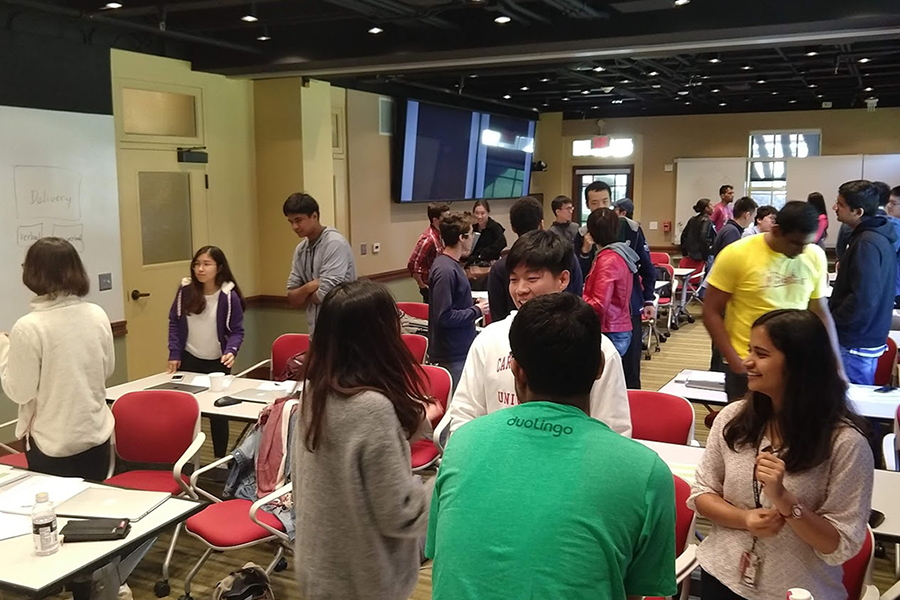
CMU professors advance flipped classroom format
By Anna Boyle
When some people hear the phrase “flipped classroom,” they might think of a room where all the desks are stuck to the ceiling. For an increasing amount of college students, however, it’s just a part of their daily routine. A flipped classroom is a teaching method where students learn the theory outside of class and apply it in practice during class—in other words, homework and lectures are flipped.
This method is becoming more popular in universities, including Carnegie Mellon. Dr. Cécile Péraire and Dr. Hakan Erdogmus, professors at CMU’s Silicon Valley campus, use the format to teach a graduate Foundations of Software Engineering class (FSE). They wrote two papers about their experience, sharing the struggles and triumphs they faced as they worked toward a more efficient, helpful classroom model.
Before FSE, flipped classrooms in computer science and software engineering were limited to undergraduate programming courses. This course “was probably one of the first times that flipped classroom was applied for a graduate software engineering foundation course,” Péraire says. “So that was pretty novel back in 2014.”
But while the unknown can be intimidating, they were hopeful. Previous studies have shown that flipped classrooms can optimize class time, improve student engagement, and support abstract thinking.
Based on this research, FSE began as a pure flipped format class; classes were 100% practice and homework was 100% video lecture, with no exceptions. Like any new course format, challenges arose. “These videos were freezing the content in a way,” Péraire says. “Since software engineering is in a field that is changing rapidly, we have to be really careful about what we present as videos that will remain for several years.”
In addition to evaluating the content, Péraire and Erdogmus looked for ways to optimize the use of class time. They noticed that a portion of students struggled with the concepts, and some lacked the motivation to complete their homework. They also saw the negative effects of distance. The students were distributed among three different locations, one on campus and two remote, resulting in different needs and attention levels.
Armed with newfound knowledge, Péraire and Erdogmus began implementing changes. They shifted FSE from a pure flipped class to a mixed mode format, adding mini-lectures to explain concepts or introduce technology students would be using. In the following semesters, they separated the course into two sections, one with local students and another with two remote locations, so they could give proper attention to all their students.
Péraire and Erdogmus also confronted the problem of student motivation. After consulting with the university’s center for teaching excellence, they decided to implement weekly assessments to encourage students to better prepare for class. The assessments were low-stakes and just-in-time: low-stakes because they were quick and did not contribute to their final grade, and just-in-time because they were attached to the related instructional material, one before the video and one after.
In order to understand the effects of these assessments, Péraire and Erdogmus teamed up with Dr. Soniya Gadgil of Eberly Center to turn the implementation into a teaching-as-research project, which was featured at the 2018 CMU Teaching Summit as a poster. For the project, they divided the class into two groups and alternated which one received the assessments. “Everyone then came to class and had the same Q&A,” Péraire says. “We looked at the impact of having the pre and post test, and the answer was yes, it made a difference: students who received the assessment did significantly better during the Q&A.”
While the results were promising, not all of their hypotheses were proven. “We also tried to link the assessments to the final exam,” Péraire says, “but we couldn’t find any significant relationship. The effect of the assessment is removed once the students apply the concepts presented in the videos during in-class activities and the course project.” Nevertheless, the results still indicate that assessments were beneficial, and any step toward educational excellence, big or small, is one worth taking.
Today, with nine semesters of teaching flipped classrooms under her belt, Péraire has some suggestions for future professors of flipped classrooms. “Don’t start with videos if you’re building from scratch,” she says. “After a couple semesters, if you think you have content that is stable, then you can maybe move that content into videos.”
She also emphasizes the value of co-instruction. “Because it requires a lot of work initially, having two faculty really added value,” Péraire says. “And even two faculty can have complementary knowledge that adds depth to the breadth of the course.” Beyond faculty, she praises the role of teaching assistants in the classroom and how a mentoring relationship can be incredibly beneficial for the students.
So what does the future hold for flipped classrooms? “When I look around me,” says Péraire, “not that many colleagues are willing to go to flipped classrooms because they’re teaching very rapidly changing domains.” That’s not to say flipped classrooms don’t have a place in higher education; they just might be better suited to the more stable introductory and foundation courses. The results of their studies give a peek into potential key features of those courses, such as mini-lectures, assessments, and trained teaching assistants.
However, the role of the flipped classroom develops, future professors are lucky to have Péraire and Erdogmus’ experiences and research to guide the way.